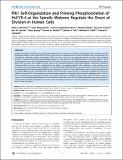Plk1 Self-Organization and Priming Phosphorylation of HsCYK-4 at the Spindle Midzone Regulate the Onset of Division in Human Cells
Author(s)
Burkard, Mark E.; Maciejowski, John; Rodriguez-Bravo, Veronica; Repka, Michael; Lowery, Drew M.; Clauser, Karl R.; Shokat, Kevan M.; Jallepalli, Prasad V.; Zhang, Chao, Ph. D. Massachusetts Institute of Technology; Carr, Steven A; Yaffe, Michael B; ... Show more Show less
DownloadBurkard-2009-Plk1 Self-Organization and Priming Phosphorylation of.pdf (3.037Mb)
PUBLISHER_CC
Publisher with Creative Commons License
Creative Commons Attribution
Terms of use
Metadata
Show full item recordAbstract
Animal cells initiate cytokinesis in parallel with anaphase onset, when an actomyosin ring assembles and constricts through localized activation of the small GTPase RhoA, giving rise to a cleavage furrow. Furrow formation relies on positional cues provided by anaphase spindle microtubules (MTs), but how such cues are generated remains unclear. Using chemical genetics to achieve both temporal and spatial control, we show that the self-organized delivery of Polo-like kinase 1 (Plk1) to the midzone and its local phosphorylation of a MT-bound substrate are critical for generating this furrow-inducing signal. When Plk1 was active but unable to target itself to this equatorial landmark, both cortical RhoA recruitment and furrow induction failed to occur, thus recapitulating the effects of anaphase-specific Plk1 inhibition. Using tandem mass spectrometry and phosphospecific antibodies, we found that Plk1 binds and directly phosphorylates the HsCYK-4 subunit of centralspindlin (also known as MgcRacGAP) at the midzone. At serine 157, this modification creates a major docking site for the tandem BRCT repeats of the Rho GTP exchange factor Ect2. Cells expressing only a nonphosphorylatable form of HsCYK-4 failed to localize Ect2 at the midzone and were severely impaired in cleavage furrow formation, implying that HsCYK-4 is Plk1's rate-limiting target upstream of RhoA. Conversely, tethering an inhibitor-resistant allele of Plk1 to HsCYK-4 allowed furrows to form despite global inhibition of all other Plk1 molecules in the cell. Our findings illuminate two key mechanisms governing the initiation of cytokinesis in human cells and illustrate the power of chemical genetics to probe such regulation both in time and space.
Date issued
2009-05Department
Broad Institute of MIT and Harvard; Massachusetts Institute of Technology. Department of Biological Engineering; Massachusetts Institute of Technology. Department of Biology; Koch Institute for Integrative Cancer Research at MITJournal
PLoS Biology
Publisher
Public Library of Science
Citation
Burkard ME, Maciejowski J, Rodriguez-Bravo V, Repka M, Lowery DM, et al. (2009) Plk1 Self-Organization and Priming Phosphorylation of HsCYK-4 at the Spindle Midzone Regulate the Onset of Division in Human Cells. PLoS Biol 7(5): e1000111.
Version: Final published version